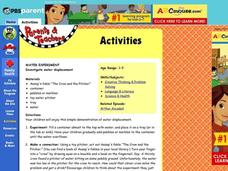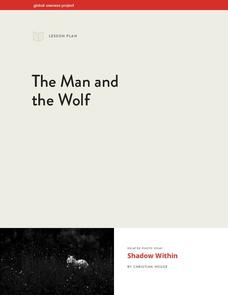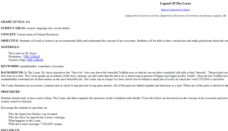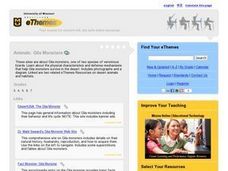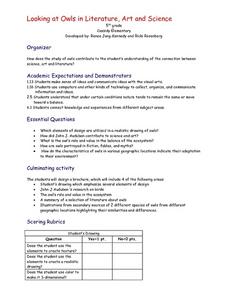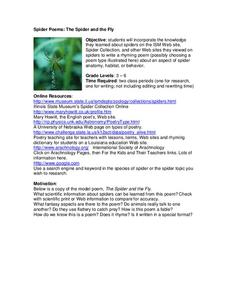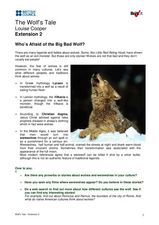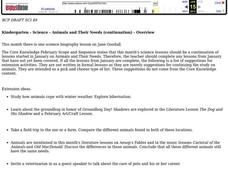Curated OER
Interplanetary Distance and Travel Time
Students are introduced to the challenges involved in understanding the space travel distances and the time involved to do so through the use of an interactive fable. The modeling and comparisons deal with specific distances at different...
Curated OER
Fable of the Fainting Goat
Second graders explore animal life by reading children stories in class. In this goat fable lesson, 2nd graders read several books which describe the different myths and folklore about goats. Students identify the needs of living animals...
Curated OER
The Fabled Maine Winter
Students graph and analyze scientific data. In this research lesson students use the Internet to obtain data then draw conclusions about what they found.
NWT Literacy Council
Readers Theatre Scripts
Engage and entertain young learners with this collection of readers theatre activities. With over 25 different scripts, a wide range of topics are covered from simple counting and rhyming exercises to adaptions of popular children's...
Curated OER
Water Experiment
Here is a great lesson designed for very young scientists. In it, they act out the famous Aesops fable, "The Crow and the Pitcher." In doing this, they get to experience water displacement first-hand. Some terrific extension activities...
Curated OER
The New Explorers: Miracle Dolphin
Learners view "Miracle Dolphin" which tells the fascinating story of a fable that came true and explores both the story and the science of Holly's life among the Bedouins of Nuweiba El Muzena.
Thoughtful Education Press
Compare and Contrast
Encourage readers to compare and contrast the information that they find in informational text with a variety of reading passages and worksheets. Learners read all about subjects in science, social studies, and literature...
Curated OER
Trees for Many Reasons
Students, by reading fables such as The Lorax, Dr Seuss or The Man Who Planted Trees, Jean Giono, examine the importance of conserving natural resources.
Polar Trec
Talk Story: A Native Way of Knowing
The steps of the scientific method examine a problem, make a prediction, and attempt to solve the problem—similar to the path most stories take. In the activity, individuals see how stories can explain natural events similar to the way...
Global Oneness Project
The Man and the Wolf
Human attitudes toward the big bad wolf come into focus in a photo essay that asks viewers to consider their own feelings about the endangered species.
K5 Learning
Force
Follow-up a physical science lesson with a reading passage that connects sports to force. Readers respond to six short answer questions that requires them to use the text as a basis for the answers.
K5 Learning
Rocks
Five short answer questions follow an informational reading passage that details the three different types of rocks—sedimentary, igneous, metamorphic—and their rock cycle.
Montana State University
One Mountain, Many Cultures
Americans may think of Mount Everest as a region dedicated to adventurous hikers, but many cultures have flourished there! Learners read informative books, watch videos, participate in classroom discussion, analyze folk tales, and...
Curated OER
Legend of The Lorax
Students explore ecosystems. They read or listen to Dr. Seuss' The Lorax to draw conclusions and make predictions about the environmental impact and use of resources. They write poems about real forests and the wildlife which inhabit...
Curated OER
Investigative Case - Protistan Tales of Atlantic White Cedar Swamps
Students use this WebQuest to explore the vast diversity of microbes, especially those microbes of the Atlantic Cedar Swamps. They tell a story about the protests of the Atlantic Cedar Swamp in the form of anthropomorphism.
Curated OER
Learning Activities: Magic Words
Students use poetry to compare and contrast humans and frogs.
Curated OER
Animals: Gila Monsters
Students research sites about Gila monsters. They explore the physical characteristics and defense mechanisms that help Gila monsters survive in the desert. Includes photographs and a diagram.
Curated OER
Spider Poems: The Spider and the Fly
Students review the information they gathered on different websites to write a poem about spiders. They use other websites to gain more information if needed. They share their poem with the class.
Curated OER
Looking at Owls in Literature, Art, and Science
Fifth graders investigate the characteristics of owls through various science and art activities. They analyze drawings by J.J. Audubon and complete a Venn diagram comparing the similarities and differences of different kinds of owls,...
Curated OER
The Spider and the Fly
Students incorporate the knowledge they learned about spiders on the ISM Web site, Spider Collection, and other Web sites they viewed on
spiders to write a rhyming poem (possibly choosing a poem type illustrated here) about an aspect of...
Curated OER
KWL Chart: Living and Non Living
In this KWL chart worksheet, students fill in this graphic organizer about living and non-living things. Students complete 3 sections in the chart.
Curated OER
The Wolf's Tale: Louise Cooper: Extension 2
In this wolves learning exercise, students complete 3 pages of extension activities pertaining to wolves, their endangered status, and fear of wolves in history and literature. This is intended to be an extension after reading The Wolf's...
Curated OER
Earth Day
Third graders utilize technology to access, analyze, interpret and communicate information about Earth Day.
Curated OER
Jane Goodall
Students identify Jane Goodall as a scientist who studies the behavior of chimpanzees. They listen to a biography of Jane Goodall and review the location of Africa. Then students participate in an animal observation activity.
Other popular searches
- Writing Fables
- Morals Fables
- Aesop's Fables
- Characteristics of Fables
- Fables and Fairy Tales
- Aesops Fables
- Myths Fables
- Aesop Fables
- Lesson Plans on Fables
- Fables and Myths
- Writing Fables and Folktales
- Writing Fables Middle School




